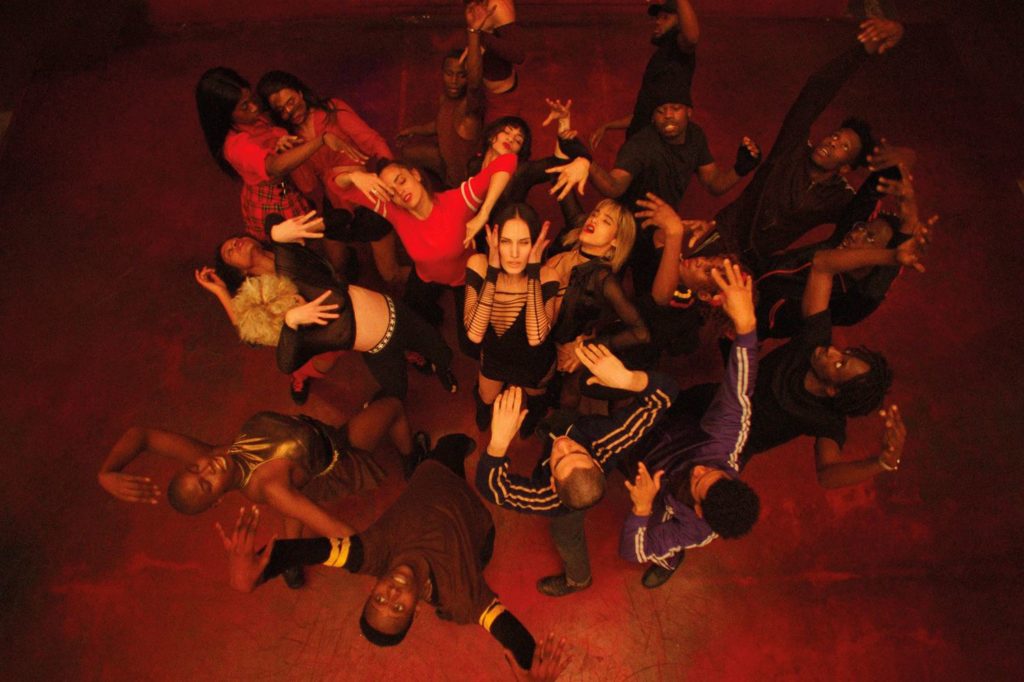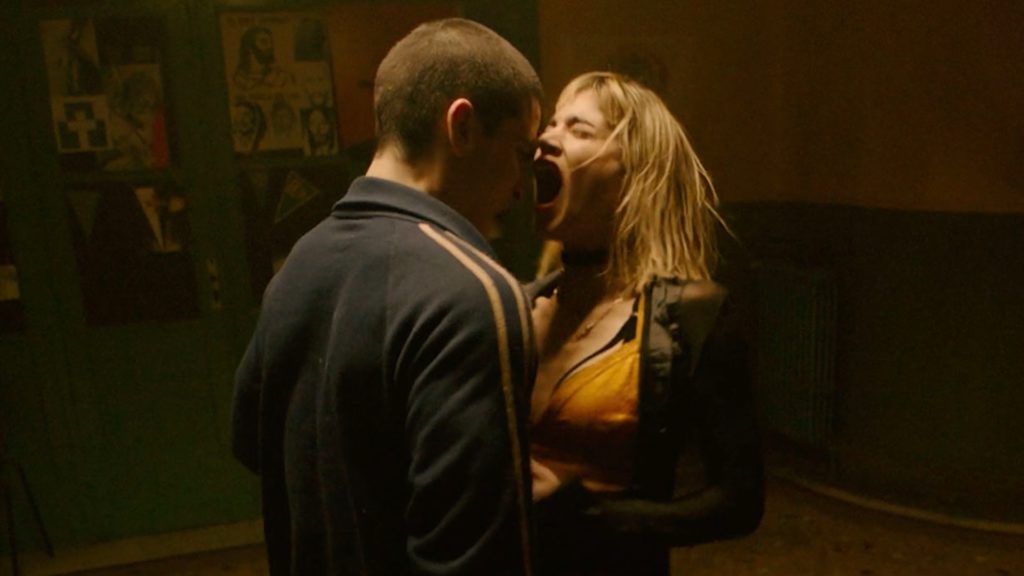
Some movies climb the walls, but in Climax, the walls blur into the ceiling and the floor. In this ambitious and enervating whatsit from the French-Argentine provocateur Gaspar Noé, the camera floats and swirls and glides, taking delirious flight through the air as bodies writhe before it in blissed-out ecstasy and unhinged agony. At one point, it becomes unclear whether the characters are vertical or horizontal, and they’re surely tripping too hard to tell the difference. It’s a dazzling visual achievement, which makes it all the more frustrating that Climax is, well, a Gaspar Noé film, which means that its technical audacity is marshaled in the service of cardboard characters, repugnant themes, and a story that is by turns skeletal and grotesque. Few directors have labored so much, and with such evident skill, to produce art that means so little.
Following the relentless banality of Love, a 135-minute borefest whose notion of boldness was to slather a dozen explicit sex scenes on top of its monotonous chronicle of a doomed relationship, Climax finds Noé returning to the lurid violence and operatic camerawork of his prior two features, Irreversible and Enter the Void. That’s for the best; despite its surfeit of stimulated genitals and spurting fluids, Love found Noé out of his element, straining to tell a character-driven story with a minimum of visual embellishment. (Well, relative minimum; as with Enter the Void, Love featured a POV shot of a penis ejaculating inside a vagina.) He’s far more comfortable trafficking in ornate brutality, which he likes to turn arty with pounding music and sweeping long takes. Working again with his regular cinematographer, Benoît Debie, Noé takes the ostensibly flat setting of Climax—an abandoned high school in France—and, with unflinching verve, transforms it into a hellish landscape of quaking terror, the Parisian equivalent of the Overlook Hotel.
That Climax manages to exist as a movie at all is weirdly impressive, given that its premise sounds like something a stoned teenager might have dreamt up while passed out in a nightclub as “One More Time” plays on a loop. It follows a large dance troupe prepping for a big competition; after they finish their rehearsal, work turns into play, and they blow off steam via a boisterous party. There’s just one problem: Somebody spiked the sangria with LSD. From there, to quote another enfant terrible of European art cinema, chaos reigns.

The narrative simplicity of Climax is hardly a mark against it. The problem is that it operates as a vehicle for Noé to indulge in his base instincts, or maybe just his true calling. He loves watching impassively as beautiful people do terrible things, fighting and fucking and smashing each other into bits; in Noé’s films, copulation and mutilation often exist side by side and are sometimes indistinguishable from one another. The depravity on display in Climax isn’t as grisly as the most shocking bits from Irreversible or as carnal as any random scene from Love, but it’s equally empty, lacking any reason to exist beyond vulgar showmanship.
And it must be acknowledged: Noé is a gifted showman. The opening dance sequence in Climax is an absolute stunner, a thrilling medley of twisting torsos and whirling limbs. (The cast is composed entirely of professional dancers with no acting experience, with the pitiable exception of the great Sofia Boutella.) Noé captures everything with an elusive combination of energy and precision, his camera constantly pushing in and pulling out but never seeming rushed. Later, as the bacchanal turns into a nightmare, he strolls beyond the central gymnasium, wandering down long corridors and into cramped rooms with a sociologist’s curiosity. The camera’s placidity never varies, but the colors do; different locations acquire their own hypnotic tint—cherry red, artichoke green, berry blue—as though they’re advertisements for sickly, off-brand Skittles. With purpose and poise, Noé turns a mundane environment into an aesthetic wonderland. But his fantasia is one built out of puke, piss, and blood.

His characters, meanwhile, are mostly made of bile. Climax features two early scenes bookending its centerpiece dance sequence, each designed to briskly map out the dancers’ various personalities. It’s hard to say which is worse. The first is a series of recorded interviews, with the applicants answering insipid questions about life and drugs and America; these Q&As are presented on a boxy ’90s television that’s framed by an array of books and VHS cassettes. The questions and answers are so dull that Noé, ever obsessed with references and influences, seems to be inviting you to ignore the subtitles and cast your eye about for particular titles on the spines. (I first landed on the blocky lettering of the original Suspiria, though I also noticed Un Chien Andalou and something by Fritz Lang.)
The second bookend is equally dreary but far more noxious. After the rehearsal concludes (but before the acid has kicked in), the dancers spread across the gym in pairs, and Noé cuts among them, eavesdropping on discussions of varying degrees of foulness. The director didn’t write any dialogue for the film, instead encouraging his non-actors to improvise all of their lines. It shows. The snippets of talk that we observe possess neither the rhythm of genuine conversation nor the polish of half-decent screenwriting. Instead, the dancers mostly natter about who’s hot, who’s had sex with whom, and who’s an appropriate target for their next conquest. Nobody will ever confuse Noé with Sturges or Bergman, but Climax arguably represents his nadir as a writer. This is a movie where the closest thing to a philosophical question is two men pondering whether nonconsensual anal sex should be performed dry or with lube.

These chatty scenes—which Noé unwisely attempts to enliven with constant cuts to black, an annoying editing gimmick that he used to equally poor effect in Love—are hardly the point of Climax; they’re really just filler until the drugs heat up and Noé can get down to his dirty business. Yet their ugliness and vacuity cast a dark shadow over the rest of the film. Climax is full of gonzo moments that could be queasily compelling were they attached to minimally interesting characters: a woman carving up her own face with a knife, a child being helplessly locked in a storage closet, a junkie’s hair catching on fire. But Noé passes his intellectual remove on to his audience, rendering us less awestruck witnesses to a horror show than impatient customers at a carnival. (When one character sees herself in the mirror and shrieks in response, I laughed, but I didn’t sympathize.) The final act of mother! was even more outré, but its dreadful excesses nevertheless carried a human charge thanks to Jennifer Lawrence. Climax offers viewers no such life raft; it instead wants to drown you in its filth.
And for all its visual and sonic flair—the gently levitating camera, the experimental credits and title cards, the incessant house beats, the pop-music samples ranging from Daft Punk to Gary Numan to the Rolling Stones—Climax’s perpetual crescendo ultimately produces a sensation of extreme tedium; it’s a never-ending, ear-splitting scream in dire need of a Mute button. Noé fancies himself a bravura stylist who’s turning the world’s most lavish dance party into a fever dream, but he’s really just a charlatan playing a perverse, demented game of musical chairs. And amid all the noise and the haze, the death and the drugs, one thing becomes dispiritingly clear: The person left standing is you.
Grade: C-
Jeremy Beck is the editor-in-chief of MovieManifesto. He watches more movies and television than he probably should.
